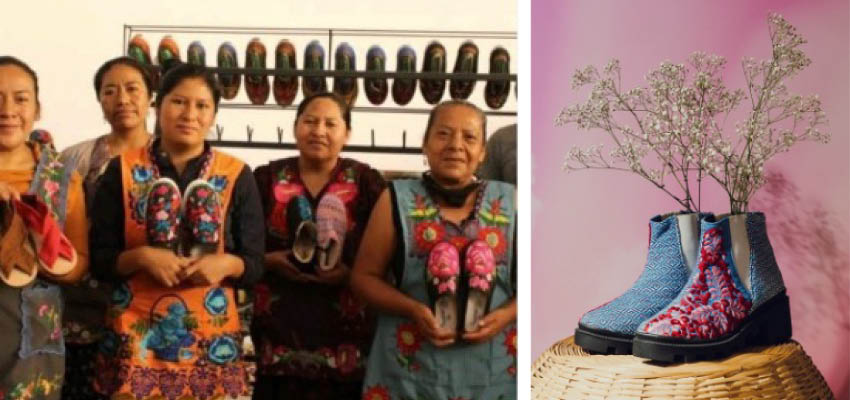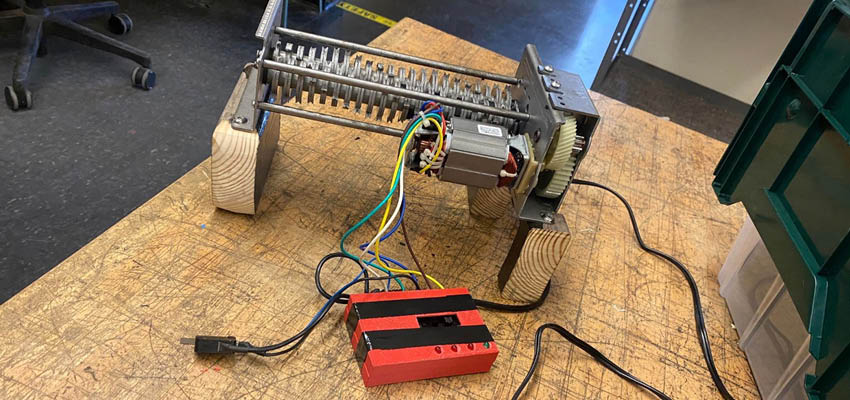
MIT D-Lab class
Creating a low-cost rubber shredder for an indigenous-owned and family-operated Oaxacan shoe company to support their sustainability efforts.
Student team
MIT students unless otherwise noted.
- Porter Bowen ‘25: Porter is a junior in chemical engineering interested in the intersection of sustainable materials and large scale manufacturing.
- Ben Carlson ‘25: Ben is a junior in mechanical engineering focused on electromechanical design, compliant mechanisms, and control systems.
- Tyler Ea ‘25: Tyler is a junior in mechanical engineering focused on the mechanical design of high temperature superconducting cables in nuclear fusion applications.
- Sally Kim ‘25 (Wellesley): Sally is a junior in mathematics and computer science at Wellesley College interested in the theory behind algorithms and discrete math.
- Brittany McHenry ‘25: Brittany is a junior in mechanical engineering interested in design, manufacturing, and sustainability.
Community partners
- DAVA Artesanal
- Tejiendo Alianzas
- Richard Hanson, Co-Founder of Tejiendo Alianzas
Location
Oaxaca, Mexico
Problem
Mexico’s overall poverty rate is 50%, but Oaxaca’s poverty rate is nearly 70%. The community mostly consists of indigenous groups. A local Oaxacan family started DAVA Artesanal, a shoe company, with the goal of improving the lives of their community and operating sustainably. DAVA Artesanal has worked extensively to achieve these goals: all while maintaining job security for their workers and keeping the human element alive in production. However, they have yet to find a way to reduce their rubber waste and are left with irregular scraps unfit for other uses. Local recycling cannot accommodate the rubber and external recycling is too costly, forcing DAVA to throw the rubber away. As DAVA Artesanal seeks to increase its production efficiency and live out their goal of sustainable production, our goal is to figure out a design for a cost-effective, safe, and simple-to-operate rubber shredder.
Cultural context
DAVA Artesanal prides itself on creating handmade shoes with locally sourced materials and employing indigenous people – particularly Oaxacan women. The indigenous groups of Oaxaca live their lives with environmentalism in their hearts, and DAVA Artesanal exemplifies this value. Handmade production is also central to the company; thus, they prioritize workers’ jobs over the adoption of expensive and overly automated equipment. While trying to reduce rubber waste, DAVA Artesanal hopes to re-utilize scrap rubber for new shoes or other sustainable uses.
Proposed solution
- Adapt a paper shredder*, with metal gears, to grind down the waste EVA.
- Make several passes through the shredder until the rubber crumbs look uniform in size (ours were typically ≤5 mm after 3 passes).
- The smaller the particles, the better the end result. - Mix together the EVA crumbs and a two part polyurethane resin system.
- De-gas the mixture for up to 5 minutes to prevent bubble formation inside the mix.
- Pour the mixture into a shoe sole mold and allow it to cure over 8 hours. The result should be a product similar to the 100% EVA rubber soles.
*We also plan on sharing the idea to adopt a commercial rubber grinder. Despite its high initial cost, a commercial grinder would be able to work faster and give more consistent results (and smaller particles) to use in the sole recipes above.

Next steps
- Liquid Nitrogen (LN2) Testing:
- LN2 has the potential to cool EVA rubber past its glass transition temperature, making the rubber more brittle and more easily shattered into smaller pieces.
- Exact efficacy of LN2 should be determined.
- Further Polyurethane/EVA Ratio Tests:
- We must also determine the optimal ratio of virgin polyurethane to EVA to create a similar product to pure EVA.
- Mold Verification:
- We need to determine the optimal mixture amount for the shoe molds to recreate the original product.
Contact
Ankita Singh or Eliza Squibb, Co-Instructors Leadership in Design

